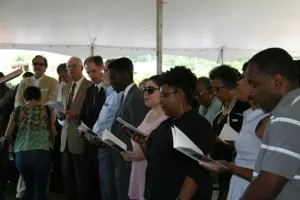The interfaith prayer ceremony Sunday, May 21, marking the centennial of the lynching of Ell Persons included several mentions of the removal of Confederate monuments in the last month in New Orleans.
But during the two-hour ceremony in a field off Summer Avenue near the lynching site there were no overt calls for the city of Memphis to take the same approach of removing such monuments without advance notice.
U.S. Rep. Steve Cohen of Memphis called the actions in New Orleans “commendable.”
“Monuments and memorials to people of that time are monuments to people who were treasonous and supporters of slavery.” Cohen said to applause from a group of several hundred people who filled a large tent and stood outside the tent.
Rev. Roslyn Nichols also talked about the Confederate monuments on a day when two new historical markers on the Persons lynching were unveiled.
“Removing them does not change history,” Nichols said of the Confederate monuments. “But it acknowledges our choice in how we recognize our history,” “So as we work to take down monuments of pain and suffering, we erect those that help us to honor all and acknowledge the fullness of our history.”
Memphis Mayor Jim Strickland did not comment on the issue of Confederate monuments here or in New Orleans, although in recent weeks some activists have pushed via social media for the city to act. The city is involved in an ongoing lawsuit over plans during the administration of Mayor A C Wharton to remove Confederate monuments in three city parks that have since been renamed.
As a city council member, Strickland was a part of the unanimous council vote for the removal of the monuments.
“We’re obviously not here to right a wrong because we simply cannot. But to me we’re here to make sure that we acknowledge the wrong,” Strickland said of the lynching centennial. “So that all of our community is aware and all of our community remembers. One hundred years ago part of the Memphis community gathered here to kill someone, celebrate evil, to further racism and encourage hate. Today we gather as a community to remember but celebrate our current community with further dialogue and to encourage healing.”
Confederate monuments weren’t the only present-day issue that surfaced in the Persons anniversary.
“The criminal justice system is still messed up today,” said Rev. Andre Johnson.
Persons was burned alive May 22, 1917 by a mob that took him from a train on its way back to Memphis where he was to stand trial for the rape, murder and decapitation of Antoinette Rappel.
A crowd estimated at 5,000 people watched the lynching on the Macon Road Bridge across the Wolf River, which was also where Rappel’s body was found.
After Persons was burned alive, the mob beheaded the corpse and threw the head into a crowd of people on Beale Street. Postcard images of the head were also distributed after the lynching which was covered extensively by local newspapers in advance of the event.
A century later, the group that came for the prayer service found its way after the service through a winding path to two concrete bridge supports overtaken by the thick spring to summer undergrowth by what is now an oxbow lake. The bridge supports are all that is left of the bridge and the site.
Among those throwing rose petals along the wooded trail and in the waters were Michele Lisa Whitney, a descendant of Persons and Laura Wilfong Miller, a descendant of Rappel.
The service was organized by the Lynching Site Project whose goal is to mark all of the sites of lynchings in Shelby County. The group and its partners gathered at the same site a year ago to begin the effort toward Sunday’s observance.
Timothy Good, superintendent of the National Park Service, called the lynching “tough history.”
“This is exactly the history people love to run away from,” he added. “There’s no way you can understand today without understanding an event such as this.”
Good was in Memphis last year for the unveiling of a historical marker on the 1866 Memphis Massacre when white mobs, led by the Memphis Police Department, killed 46 black citizens over a three-day period in which they also burned every black school and church in the city.
Source date:
May 22 2017








































